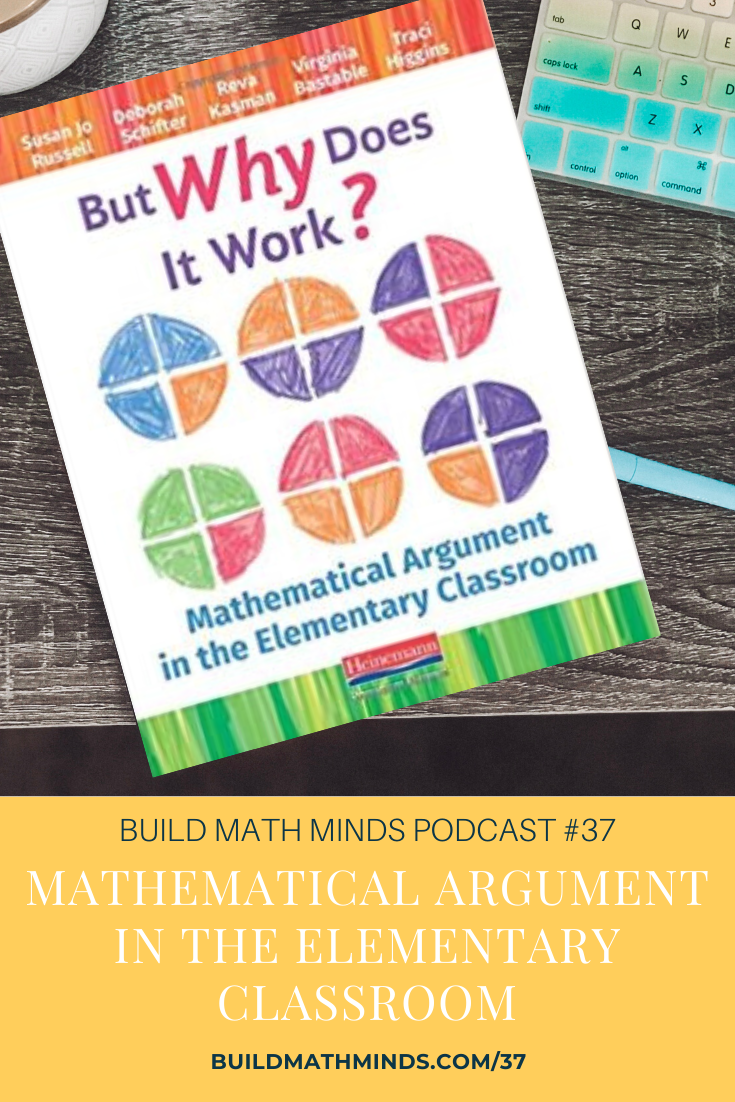Resources mentioned in this episode:
But Why Does it Work? Mathematical Argument in the Elementary Classroom by Russell, et al
Welcome fellow Recovering Traditionalists to Episode 37. Today we are looking at building Mathematical Argument in the Elementary Classroom.
Before we get into the episode I wanted to take a moment to say thank you. We aren’t even to 40 episodes and we are almost at 100,000 downloads of this podcast! Thank you so much for listening in and if you haven’t already, please make sure to subscribe. The more subscribers the podcast has, the more downloads it gets, and then the algorithm behind the scenes starts to push the podcast out to get it in front of more educators. Your subscription and downloads helps this podcast reach even more educators out there each week. So thank you so much for your support. Let’s get into the book I want to share with you.
I love understanding the WHY to anything. I wasn’t always that way. I used to be that good student who would just follow and do whatever my teachers told me to do. It seemed as though teachers would get irritated by those kids who would ask WHY…WHY does this work? WHY do I have to learn this?
So quickly students learn to stop asking WHY. But the change in math education has brought the need for kids to investigate WHY to the forefront. The book I’m sharing with you today talks about WHY kids need to investigate the WHY and how to do it in your classroom. But Why Does it Work? Mathematical Arguments in the Elementary Classroom by Susan Jo Russell, Deborah Shifter, Reva Kasman, Virginia Bastable, and Traci Higgins gives us a framework on how to encourage that mathematical argument in our classrooms.
On pages 28-29, they write:
“The teaching model comprises five phases:
- Phase I: Noticing regularity. Students examine pairs or sequences of related problems, equations, or expressions and describe patterns they notice.
- Phase II: Articulating a claim. Based on the patterns noticed in Phase I, students work individually and collectively to write a conjecture clearly enough so that someone not in the class could understand it.
- Phase III: Investigating through representations. Students represent specific instances of the claim with manipulatives, diagrams, or story contexts.
- Phase IV: Constructing arguments. Students use representations to explain why the conjecture must be true for all numbers of a certain class (e.g., all whole numbers, all positive rational numbers, etc.).
- Phase V: Comparing operations. Once students have verified a claim, they consider the question, Does this work for other operations? Returning to Phase I, students consider a set of problems, equations, or expressions that illustrate an analogous claim for another operation. They then go on to the Phases II through IV to examine and prove a conjecture about the second operation.
Although these phases might be considered stages of an investigation, they are not necessarily district and don’t necessarily follow exactly in this order. As illustrated in Chapter 1, students might work with representations as they engage in noticing or in articulating a claim. Or they might contrast operations before they construct arguments that explain why the different generalization must be true. However, these five phases constitute the essential aspects of mathematical argument and are the skeleton upon which the lesson sequences are built.”
The book goes on to explain each phase in more detail through real classroom examples and then the last part of the book is full of examples you can use in your classroom to help build mathematical arguments.
Now remember with all of these episodes I don’t go deep into the book or article because if this is an area you want to learn more about, then I want you to go learn it straight from the source. We are all different learners and teachers and what I take away from a book or article might be different than what you take away. So if you want to learn more about how to build that mathematical argument in your classroom, go get the book.
Subscribe and Review in iTunes
Hey, are you subscribed to the Build Math Minds Podcast, yet? If you’re not, make sure to do that today because I don’t want you to miss any episodes! Click here to subscribe to the podcast in iTunes.
While you’re there, don’t forget to leave a review on iTunes too. I would love to know your thoughts and how we can make sure that we give you content that you will really enjoy.
To leave a review, head over to iTunes and click on “Ratings and Reviews” and “Write a Review.” I can’t wait to hear your thoughts about the podcast.





I enjoy all your podcasts! They inspire me to be a better educator and to give my students the critical thinking skills needed for math and everyday life.